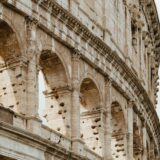15 Interesting Facts about the Colosseum

The Colosseum, also known as the Flavian Amphitheatre, is an iconic symbol of Rome’s imperial grandeur and an architectural marvel of the ancient world. This gigantic structure has witnessed the rise and fall of the Roman Empire and survived earthquakes, wars, and the ravages of time. Here are 15 interesting facts about the Colosseum, a monumental testament to ancient Roman engineering and culture:
- The Colosseum had a seating capacity of over 50,000 spectators. This is comparable to many of today’s modern sports stadiums. Spectators would be seated according to their social status and gender, with Senators and the elite getting prime spots, while women and slaves were relegated to the higher tiers.
- The Colosseum was not just used for gladiatorial combat. In its early days, it was sometimes filled with water to re-enact naval battles known as “naumachiae”. Historians believe that the Colosseum was equipped with special machinery to flood the arena for these spectacular mock battles.
- Below the floor of the arena was a maze of tunnels and chambers known as the “hypogeum.” This complex underground system was used to house gladiators, animals, and props. With the help of pulleys, lifts, and trapdoors, they could be quickly brought into the arena, adding an element of surprise to the events.
- The Colosseum was equipped with an enormous retractable awning system, known as the “velarium.” Operated by a team of sailors, this covered two-thirds of the arena and provided shade for the spectators, protecting them from the scorching sun and occasional rain.
- For many years, it was believed that countless Christians were martyred in the Colosseum. However, modern historians suggest that these events might have been exaggerated over time. While there’s evidence of Christian martyrdom in other Roman arenas, specific records of such events in the Colosseum are scant.
- Emperor Titus officially inaugurated the Colosseum in 80 AD with a grand celebration that lasted 100 days. During this period, numerous gladiatorial combats, wild animal fights, and other events were held.
- Over the centuries, the Colosseum faced neglect, earthquakes, and stone robbers, which led to its dilapidated state. In the Middle Ages, it was repurposed into housing, workshops, and even a fortress. It wasn’t until the Renaissance period that there was a renewed interest in its preservation as a historical monument.
- The Colosseum’s original Latin name, “Amphitheatrum Flavium”, derives from both Emperor Vespasian and his son Titus’s family name (Flavius). Vespasian began its construction, and Titus completed it. The subsequent modifications were done by Emperor Domitian, also a Flavian.
- Today, the Colosseum serves as a symbolic reminder of Rome’s glorious past. But it’s also a thriving habitat for various plant species. Surprisingly, researchers have identified over 200 species of plants in the Colosseum, some of which are believed to have originated from the exotic animals that were once brought here for combat.
- During ancient times, it was free admission for all. The events at the Colosseum were free for Roman citizens. The state-sponsored games and events were a means of gaining political favor and demonstrating the wealth and generosity of the Roman elite.
- The games in the Colosseum displayed animals from all corners of the Roman Empire, including lions from Africa, bears from Europe, and even elephants. This not only provided a spectacle but also showcased the vast reach of the Roman Empire.
- The Colosseum was ingeniously designed. It had 80 entrances, allowing for the efficient movement of its tens of thousands of spectators. Its elliptical shape ensured that everyone had a good view of the events taking place in the center.
- In the 18th century, Pope Benedict XIV consecrated the Colosseum and declared it a sacred site in memory of the Christian martyrs who were believed to have died there. He installed the Stations of the Cross, transforming it into a place of Christian pilgrimage, and prohibited its use for any profane purposes henceforth.
- Despite being damaged by numerous earthquakes, fires, and stone robberies over the years, approximately two-thirds of the Colosseum remains intact today, which speaks volumes about the quality of Roman engineering and construction.
- The Colosseum’s design has been influential in the construction of modern-day sports stadiums, particularly the use of arches and the idea of having tiered seating to accommodate large crowds. Its iconic status has made it one of the most recognized structures globally, featuring in movies, books, and art.
Above are the 15 interesting facts about the Colosseum that we’ve gathered. From its bloody gladiatorial combats to its stature as an enduring symbol of Rome’s ancient might, the Colosseum remains an architectural marvel and historical treasure that attracts millions of visitors each year. The Colosseum continues to captivate historians and travelers alike with its intricate details and rich history.
Secure your tour today and allow us to be your companions on a hassle-free exploration of ancient Roman history! You can also book your tickets in advance for added convenience.
Don’t wait any longer – reserve your tour now!
 Spanish
Spanish
